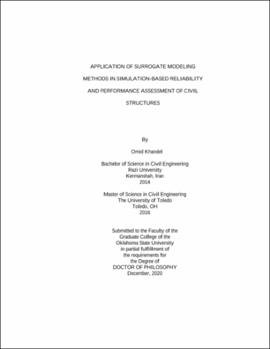| dc.contributor.advisor | Soliman, Mohamed | |
| dc.contributor.author | Khandel, Omid | |
| dc.date.accessioned | 2021-05-25T20:32:06Z | |
| dc.date.available | 2021-05-25T20:32:06Z | |
| dc.date.issued | 2020-12 | |
| dc.identifier.uri | https://hdl.handle.net/11244/329916 | |
| dc.description.abstract | Structures and infrastructure systems are subjected to various deterioration processes due to environmental or mechanical stressors. Proper performance assessment approaches capable of detecting potential structural damage and quantifying the probability associated with structural failure are required to formulate optimal maintenance and retrofit plans that minimize the risk of failure and maximize the safety of structures. However, due to the presence of several sources of uncertainty that can affect the performance assessment and decision-making processes (e.g., uncertainties associated with loading conditions and performance prediction models), applying probabilistic methods, such as Monte Carlo simulation, is essential. In this context, a large number of simulations is generally required to quantify the low failure probability associated with civil structures. Executing the required number of simulations may be computationally expensive, especially if complex and/or nonlinear structural models (e.g., finite element models) are involved. The use of surrogate modeling tools such as artificial neural networks, polynomial chaos expansion, and kriging can help in reducing the computational costs associated with simulation-based probabilistic analysis. The research proposed herein aims to develop probabilistic approaches for performance assessment and damage detection of structures using advanced simulation-based techniques coupled with surrogate modeling. The proposed methodology is applied to quantify the risk of bridge failure due to flood events considering the impact of climate change. The approach was extended to establish the time-variant flood fragility surfaces for bridges under flood conditions. This approach (a) integrates deep learning neural networks into a simulation-based probabilistic approach to predict the future river streamflow necessary for assessing the flood hazard at the bridge location and (b) simulates the structural behavior of the bridge foundation under sour conditions. In addition, the proposed methodology is used to quantify the reliability of bolted and welded steel connections by integrating finite element analysis and surrogate models. Low-rank tensor approximation and polynomial chaos kriging surrogate models are adopted to perform Monte Carlo simulation and quantify the reliability of the investigated combination connection. Finally, artificial neural networks were used to develop a statistical damage detection and localization approach capable of evaluating the performance of prestressed concrete bridge girders using fiber optic sensors. | |
| dc.format | application/pdf | |
| dc.language | en_US | |
| dc.rights | Copyright is held by the author who has granted the Oklahoma State University Library the non-exclusive right to share this material in its institutional repository. Contact Digital Library Services at lib-dls@okstate.edu or 405-744-9161 for the permission policy on the use, reproduction or distribution of this material. | |
| dc.title | Application of surrogate modeling methods in simulation-based reliability and performance assessment of civil structures | |
| dc.contributor.committeeMember | Russell, Bruce W. | |
| dc.contributor.committeeMember | Ahmed, Samir A. | |
| dc.contributor.committeeMember | Ekin, Sabit | |
| osu.filename | Khandel_okstate_0664D_17014.pdf | |
| osu.accesstype | Open Access | |
| dc.type.genre | Dissertation | |
| dc.type.material | Text | |
| thesis.degree.discipline | Civil Engineering | |
| thesis.degree.grantor | Oklahoma State University | |
